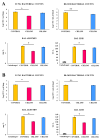Orally Administered Lactobacilli Strains Modulate Alveolar Macrophages and Improve Protection Against Respiratory Superinfection
- PMID: 39766307
- PMCID: PMC11674826
- DOI: 10.3390/biom14121600
Orally Administered Lactobacilli Strains Modulate Alveolar Macrophages and Improve Protection Against Respiratory Superinfection
Abstract
Orally administered immunomodulatory lactobacilli can stimulate respiratory immunity and enhance the resistance to primary infections with bacterial and viral pathogens. However, the potential beneficial effects of immunomodulatory lactobacilli against respiratory superinfection have not been evaluated. In this work, we showed that the feeding of infant mice with Lacticaseibacillus rhamnosus CRL1505 or Lactiplantibacillus plantarum MPL16 strains can reduce susceptibility to the secondary pneumococcal infection produced after the activation of TLR3 in the respiratory tract or after infection with RVS. The treatment of mice with CRL1505 or MPL16 strains by the oral route improved the production of interferons in the respiratory tract, differentially modulated the balance of pro- and anti-inflammatory cytokines, reduced bacterial replication, and diminished lung damage. Additionally, we demonstrated that orally administered lactobacilli confer longstanding protection against secondary Streptococcus pneumoniae infection and that this effect would be mediated by the stimulation of trained alveolar macrophages. This work contributes to revealing the mechanisms involved in the modulation of the gut-lung axis by beneficial microbes by demonstrating that specific lactobacilli strains, through the stimulation of the common mucosal immune system, would be able to support the development of trained alveolar macrophages that would confer longstanding protection against secondary bacterial challenges produced after a primary inflammatory event in the respiratory mucosa.
Keywords: Lacticaseibacillus rhamnosus CRL1505; alveolar macrophages; probiotic lactobacilli; respiratory immunity; superinfection.
Conflict of interest statement
The authors declare no conflicts of interest.
Figures






References
-
- GBD 2016 Lower Respiratory Infections Collaborators Estimates of the Global, Regional, and National Morbidity, Mortality, and Aetiologies of Lower Respiratory Infections in 195 Countries, 1990–2016: A Systematic Analysis for the Global Burden of Disease Study 2016. Lancet Infect Dis. 2018;18:1191–1210. doi: 10.1016/S1473-3099(18)30310-4. - DOI - PMC - PubMed
MeSH terms
Substances
Grants and funding
LinkOut - more resources
Full Text Sources

